Department of descriptive and clinical anatomy
History of department
KYIV ANATOMICAL SCHOOL
The history for department of human anatomy in Bogomolets National Medical University is rich in numerous scientific discoveries, examples of creative, selfless, self-sacrificing work of scientists and reflects the establishment of academic traditions in scientific and educational activity, being inherent to Ukrainian anatomy.
Famous national anatomist professor M.S. Spirov in 1965 in monograph “Kyiv anatomical school” mentioned that the employees and heads at department of human anatomy in medical faculty Emperor St. Volodymyr University (now department of human anatomy at Bogomolets National medical university) “developed the issues of great scientific importance, established certain directions in anatomical science with their researches”. The mentioned directions were developed due to succession in the work and enabled underlying the academic basics for department and assisting to the progress in anatomic knowledge and medical education”.
The honorary place in the row of medical scientists in XIX century, who provided the intellectual glory of Ukraine with their enthusiastic, self-sacrificing work, belongs to professor M.I. Kozlov and O.P. Walter. In this connection it is necessary to mention the old expression, by which V.O. Betz once finished one of his lectures and which can be considered as the slogan of Kyiv anatomical school: “I have made everything I could, let others do better” (“Feci quod potui , faciant meliora potentes”).
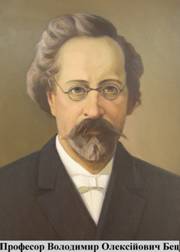
Professor Volodymyr Oleksiyovych Betz (1834-1894) was the pupil of O.P. Walter and managed the department of anatomy in St. Volodymyr University since 1868 until 1890.
V.O. Betz was born on 26, April, 1834 in village Tataryvshchyna (suburb Ostra) in Chernihiv province. He came from Ukrainian noble family, where they kept to democratic views. He acquired the secondary education in Nizhyn and 2nd Kyiv high schools. In 1853 he entered the medical faculty in St. Volodymyr University, after graduation from which in 1860 he was awarded with the degree of doctor with honors. Thanks to great successes during the study at university the talented graduate-doctor was sent to foreign trip to Vienna. In 1862 V.O. Betz returned to Kyiv and already in the next year he defended the doctor’s dissertation.
V.O. Betz was a thoroughly educated scientist, skillful experimentalist, talented researcher, excellent lecturer and demanding teacher, who passed through European school of scientific and pedagogical training at scientists with the world name: Kelliker, Bunsen, Girdle, Ludwig, Brukke, Kirchhoff and Helmholtz.
Thanks to erudition, ability to propose the new original ideas, the range of scientific interests by professor V.O. Betz was very wide. At the beginning of his scientific and pedagogical activity Volodymyr Oleksiyovych was successfully engaged into physiology, chemistry, morphological sciences. For a certain period of time V.O. Betz at the university read lectures on analytical chemistry, uroscopy, and histology to students. Having defended in 1863 the doctor’s dissertation “On mechanism for blood circulation in the liver”, he testified his deep knowledge not only in the sphere of anatomy but physics. The part of this work by Ukrainian scientist, which described the hydraulic calculations, was published in reports of Vienna academy of sciences. The scientific researches on medulla of the adrenal glands (he discovered their chromaffin reaction), researches on morphology of osteogenesis and in particular study on macro- and microscopic anatomy of brain, made by Volodymyr Oleksiyovych, are of great importance.
During all his scientific and pedagogical activity V.O. Betz kept the direct relations with practical medicine. Being a brilliant doctor-clinician, since 1871 he worked as a consultant on nervous diseases at Kyrylivska hospital and later – chief doctor in Southern Western railway.
The versatile activity of V.O. Betz did not prevent and helped to the main undertaking in his life – study on structure of brain. It is well known that the human brain is perhaps the most complex living structure of the Universe. In this connection the nervous system always was in the center of attention by scientists-researchers. Meanwhile, the expression by famous Italian anatomist in XVII century F. Fontana about the brain: obscura textura, obscuriores morhi, functiones obscurissime (which can be translated as “of obscure structure, obscure properties, and most obscure functions”) remained urgent until the end of XIX century.
The purposeful impartial study on functions of the nervous system (to a large extent of the brain and spinal chord) started in XIX century; hereby the main data were received as a result from anatomical and histological researches.
The study on functions of allocortex at that time was developing in the interaction of two opposite concepts – antilocalizationism or equipotentialism and localizationism. There had been no real anatomic evidences for fragmentation of cortex into certain structural units before appearance of architectonic works by V.O. Betz. Many researchers, determining the facts for functional difference of various sections in allocortex, did not link them up with certain morphological structures and usually considered them within Meinert’s theory of heuristic parallelism, which defined the phenomena of consciousness and material processes as quite different in essence.
The interrelation of physiology, anatomy, histology of the central nervous system and clinic of the nervous diseases was well understood to V.O. Betz, who in the introduction lecture on anatomy on 22, September, 1870 told: “If physiology is not governed by anatomy, then the theories, acquired by physiology, are dispersed by the first anatomical term… The anatomy of the brain needs in finding many facts, in their numerous explanations even needs in explaining many things, being well known but isolated one that as an isolated mile stone stands without inscription…”
Binding the structure with the function, V.O. Betz for the first time in the world started studying the cytoarchitectonic areas of the cortex. The epochal event in the history of neuroanatomy in XIX century was the discovery of giant pyramidal cells in V layer of cortex of anterior central gyrus and precentral section of great brain by V.O. Betz. V.O. Betz not only described those cells (which are called “Betz cells” since that time all over the world) but proved that they are the morphological substrate from localization of motor center, described by Fritch and Gitzig, which regulate the activity of skeletal muscles. Thus, Volodymyr Oleksiyovych became the founder of study on morphological basics for dynamic localization of functions in the cortex of cerebral hemisphere. It should be mentioned that V.O. Betz made his discovery when his contemporary famous Austrian anatomist Y. Girtle in book “Manual for anatomy of human body with indications for its physiological grounds and practical applications” (1878) wrote: “The anatomy of the brain’s internal structure at present moment and perhaps in the future may be compared with the book, closed by seven seal and written by hieroglyphs. As it concerns the study on the brain’s functions, the most prideful physiologists lowly bend their heads and confess that they know only that the human soul has no wings” (this citation contains the spelling of original).
In article “On peculiarities for structure of human cerebral cortex” (1882) V.O. Betz mentioned: “… based on my researches the cortex of anterior central gyrus and paracentral lobule contains the giant cells, located by groups in the form of nests”. It should be emphasized that until now in the neuroanatomy there is the discussion about the fact who was the first one to set the principle for columnar structure of excitable area – Vernon Mountcastle in 1960 or Lorento de No in 1943. There are all grounds to consider that it was Volodymyr Oleksiyovych Betz, who made it for the first time.
Using Marsh device for production of histological sections, V.O. Bets studied the vertical ties between neurons in different layers of the cortex and in particular in the abovementioned article he gave the following description of cortex columns: “The anterior central gyrus, starting from upper border in the lower one third of its length, has the following peculiarities from upwards: firstly the large cells, being in the significant distance from pair to pair, appear in it over the fifth layer individually and in pairs. Further, upwards these cells are grouped per three and four ones together with the nests and the distances between nests are decreased. More upwards these nets consist of more number of cells, not less than 4 and sometimes 5 and even 7 from the previous place, i.e. over the fifth layer, they come to the third layer and are located in it as if in the bound layer, penetrating one by one into the second layer, as well as into the fourth one and over the fifth one. This layer is again divided into nests to the paracentral lobule, and in the lobule itself these cells are arranged either with layers one over another, or with nests, taking different positions”.
The life of V.O. Betz is an expressive example for self-sacrificing service to anatomy, in which the scientist saw another science – philosophy of anatomy. V.O. Betz quite clearly saw the danger in speculative philosophy, which sacrificed the facts to immanent logics of explanatory scheme. Following to famous French anatomist K. Bisha, whom V.O. Betz called as “a great maestro in study of human nature”, Ukrainian anatomist thought that the philosophic methods is the reflection, i.e. considerations of subject about experience of its own activity and understanding the sense of that activity for itself. The philosophy of natural science, for example, is the consideration about experience in cognition of the nature, and philosophy of anatomy – about experience of anatomic research. In order this consideration to be fruitful it is necessary to follow to one precondition: a philosopher shall have his own experience of activity in this sphere, which serves as a subject of his considerations. Otherwise the creative thinking is just impossible as the absence of own working experience pushes to borrowing of foreign thoughts and arguments without real assurance in their rightness, to approximateness in judgments and intellectual dilettantism.
Setting the requirements for unity of experience and philosophic generalization, V.O. Betz had all grounds to consider that his own activity conformed to that requirement in full.
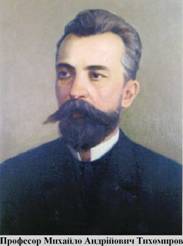
The successor of V.O. Betz at department was professor Mykhaylo Andriyovych Tykhomyrov (1848-1902). He was a nobleman since grandfather and grand-grand father, M.A. Tykhomyrov was born on 24, October, 1848 in the father’s estate in Smolensk region. After graduation from Saint Petersburg medical surgical academy in 1872 he (since 1874 until 1890) was working at department of anatomy in Moscow university, and since 1890 until 1902 at department of anatomy in St. Volodymyr University (since 1898 until 1902 he was the dean in medical faculty).
Being a great specialist in comparative anatomy and embryology, M.A. Tykhomyrov suggested considering the anatomy in terms of evolutionary morphology, on that occasion he wrote: “This point of view has been determined by success in natural science: new and surprising results from such sciences as embryology, comparative anatomy and paleontology, in their totality, provided with this new point of view…, which considers the structure of human organism not only in its absolute completed form and irrespectively but clears up the mutual dependence of facts through history for development of organism and through its comparison with other organisms”.
M.A. Tykhomyrov was a talented, original scientist, experienced and skillful teacher, classic of anatomy. Professor F.A. Stefanis emphasized that his teacher M.A. Tykhomyrov “as professor and dean, always strictly and vigilantly keep the ward of the best academic traditions”.
Just following to those academic traditions, M.A. Tykhomyrov made the consummate research on variants and abnormalities of human vascular system and, based on data of comparative anatomy and ontogenetic development, he suggested a number of such important generalization as study about main directions in phylogenesis of blood circulatory system, about principles and types of its change and about phylogenetic correlation and coordination in his monograph “Variants for arteries and veins of human body in connection with morphology of blood vascular system” (1899). M.A. Tykhomyrov worked up his own collected great material about various (including casuistical) vascular abnormalities that have the practical importance until now, and for the first time set the right point of view on their origin, based on researches of philo- and ontogenesis of vascular system. This method on historical study of anatomical facts became the significant acquisition of national angiology and further received the wide prevalence in anatomy.
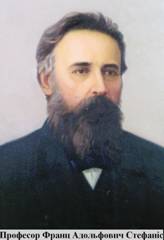
After M.A. Tykhomyrov the department of anatomy was managed (1903-1917) by professor Franz Adolfovych Stefanis (1865-1917).
F.A. Stefanis was born on 3, December, 1865 in village Dolzhytsi in Gdovsk district in Petersburg province in the family of Germans-Lutherans. His father Adolph Emily Stefanis, leasing the land at landlord, was engaged into trade of agricultural products. Soon after birth of the son he moved with family to Riga and at the beginning of the 80-ies – to Kyiv.
In 1886 F.A. Stefanis graduated from high school and in the same year entered medical faculty in St. Volodymyr University. On 7, June, 1893 F.A. Stefanis became an extraordinary assistant prosector at department of anatomy in university and approximately in a year he was transferred to the staff.
Franz Adolfovych – direct pupil of famous representative from Kyiv anatomical school by professor M.A. Tykhomyrov. Under his supervision in 1902 he defended the dissertation “Lymphatic vessels in the stomach of human”, which was made at high scientific level and was the valuable contribution into angiology. By this research F.A. Stefanis for the first time in the history of Ukrainian medical science started the successive study of lymphatic system, in this connection he is fairly considered to be a founder of national lymphology. The classical works by F.A. Stefanis “About lymphatic vessels in the kidneys of human” (1902), “Lymphatic vessels in the liver of human” (1904) were of exceptional value, thanks to them he acquired the reputation for one of the leading lymphologists at the beginning of XX century.
Having designed the original device for injection of lymphatic vessels, in which the pressing force was the mercury column with certain height and the injection mass was oil paints that were diluted in chloroform or ether or in combination of chloroform and ether, F.A. Stefanis made the original preparations for intraorgan and extraorgan lymphatic vessels.
After F.A. Stefanis the department of anatomy was managed by professor Arsen Viktorovych Starkov (1874-1927) since 1917 until 1922, who in 1918 was elected to the post of full member in Ukrainian academy of sciences. Since 1923 until 1925 he managed the department of biology in Ukrainian pedagogical institute (Prague), since 1925 until 1927 he managed the department of human anatomy in Latvian university (Riga). In 1927 A.V. Starkov was elected to the post of member in Ukrainian scientific institute in Berlin.
Professor A.V. Starkov is famous by his doctor’s dissertation “Etiology and pathological anatomy of symptomatic torticollis” (1900) and classical work “Anatomy of rectum and its associated muscles” (v. 1, 1912) and “Anatomy of bands and pacefollower of small pelvis” (v. 2, 1912).
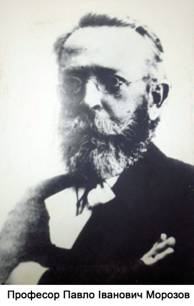
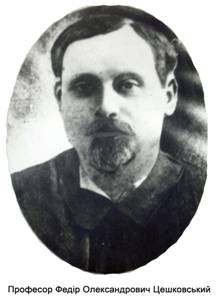
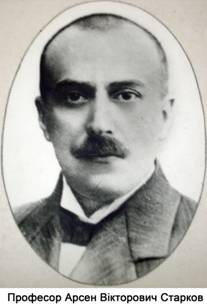
At the same time with professor A.V. Starkov the second department of human anatomy (base of former Kyiv women’s medical institute) was managed by professor Pavlo Ivanovych Morozov.
The successor of professor A.V. Starkov in department professor Fedir Oleksandrovych Tseshkovskyy graduated from medical faculty in Yuriyev (Dorpt) university and earlier worked in the sphere of anatomy in Petersburg V.M. Bekhterev psychoneurological institute at professor R. Weinberg.
When professor F.O. Tseshkovskyy was at the head of department of anatomy (1922-1924) it was transferred from anatomical theater, built at the initiative of professor O.P. Walter in 1853, to premises for department of anatomy in former Kyiv women’s medical institute (Mechnikov str., 7).
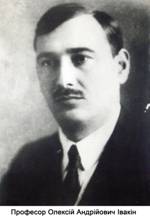
After F.O. Tseshkovskyy the department of anatomy was managed since 1924 until 1930 by professor Oleksii Andriyovych Ivakin (1883-1942).
O.A. Ivakin was born on 20, February, 1883 in Katerynoslav. He graduated from physical mathematical (1914) and medical (1916) faculties in Kharkiv university. He started as an assistant in medical faculty in Katerynoslav university (1915-1923). Later he worked as an assistant professor in Kharkiv medical institute (1923-1925). Being the heat at department of anatomy in Kyiv medical institute, at the same time he worked as a professor of anatomy and histology in Kyiv T.G. Shevchenko state university and then – professor at department of anatomy in Kyiv dental institute (1934-1939). At the same time he worked as a professor in Kyiv (1929-1932) and Bila Tserkva (1932-1935) veterinary institutes, where he taught the comparative anatomy.
Extremely active scientist and teacher, professor O.A. Ivakin is the author of over one hundred scientific works and textbooks, in particular: “Human anatomy in everyday life” (1926), “Anatomy and physiology” (1931, in co-authorship with V.N. Rubashkin), “Brief textbook of human anatomy” (1932, in co-authorship with V.P. Vorobyov and G.F. Ivanov), “Brief course on human anatomy with elements of histology and embryology” (1936).
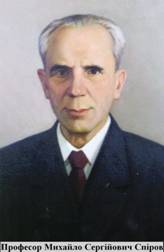 In 1930 Academic council of Kyiv medical institute elected professor Mykhaylo Serhiyovych Spirov (1892-1973) to the post of the head at department of anatomy, who in 1932 was awarded with the title of professor and in 1943 – with honored title of Honorary scientist and technician of Ukraine.
In 1930 Academic council of Kyiv medical institute elected professor Mykhaylo Serhiyovych Spirov (1892-1973) to the post of the head at department of anatomy, who in 1932 was awarded with the title of professor and in 1943 – with honored title of Honorary scientist and technician of Ukraine.
M.S. Spirov was born on 2, July, 1892 in v. Vyshegorskyy in Sergatskyy district in Nyzhegorodska province in the family of the priest. In 1917 he graduated from medical faculty in Moscow university, worked as an assistant prosector of anatomy in the Higher Moscow medical school, assistant prosector and prosector of anatomy in Kyiv medical institute, senior prosector of anatomy in Leningrad military medical academy and senior assistant at department of anatomy in Leningrad Gertsen pedagogical institute.
M.S. Spirov (a very religious person due to testimonies by employees) was a famous scientist and teacher by the will of God. In his life Mykhaylo Serhiyovych always followed to Christian principles: he was a calm, friendly, respectable, uncompromising honest person under any circumstances. Academician K.I. Kulchytskyy and Doctor of Medicine L.V. Chernyshenko (1979) recollected: “Professor always was gentle, polite, never raised his voice but could make the remark in such a way so that it would be remembered for a long time. Mykhaylo Serhiyovych told that the work at department shall be carried out on days off and holidays. Before a day off or holiday he told to L.S. Bespalova: “This day is not only for rest but for work, please do not refuse and come tomorrow to the department in order to make …” – and then he mentioned the list of tasks… This man was illimitably devoted to scientific work. M.S. Spirov often liked to repeat to his inferiors: “It is necessary to work to the best of your abilities – from all forces” but not in the imperative form but very politely… The clearness of purpose and firm will of scientist seem to be hidden behind such politeness and gentleness”.
Since 1971 until 1978 the department of human anatomy was managed by professor Igor Yevgenovych Kefeli 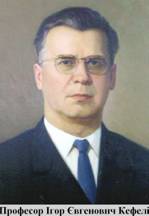 (1920-1980), talented scientist, highly intelligent person of versatile abilities. Professor I.Ye. Kefeli – author of “Atlas of schemes on human anatomy” (1963). He made much for implementation of issues on development of hemomicrocirculatory beds in prenatal period in development of human in researches by department of human anatomy.
(1920-1980), talented scientist, highly intelligent person of versatile abilities. Professor I.Ye. Kefeli – author of “Atlas of schemes on human anatomy” (1963). He made much for implementation of issues on development of hemomicrocirculatory beds in prenatal period in development of human in researches by department of human anatomy.
Since 1978 until 2004 the head at department of human anatomy was corresponding member in APS of Ukraine, Honorary scientist and technician of Ukraine, laureate of State Prize of Ukraine, professor Ivan Ivanovych Bobryk. Ivan Ivanovych is the pupil of famous topographer anatomist academician K.I. Kulchytskyy, at whose department he performed the researches on microvascular bed and intraorgan nervous elements under conditions of surgical interferences after experimental modeling different pathological states.

From 2004 untill 2020 the department of human anatomy at NMU is managed by Honorary scientist and technician of Ukraine, professor Viktor Gavrylovych Cherkasov, who is the pupil of professor I.I. Bobryk. All professional activity of V.G. Cherkasov is linked with the department of human anatomy in the native institute (now university), where he passed a long way from post-graduate student (1976), assistant (1979), senior teacher, assistant professor, professor (1992) to the head at department (since July, 2004), dean in medical faculty No 1 (since January 2008). V.G. Cherkasov successfully worked as the head in scientific research sector of university (2003-2008).
V.G. Cherkasov was the vice-president in Scientific society of anatomists, histologists, embryologists and topographic anatomists of Ukraine (since 1992), member in Academic council at MHC of Ukraine, member in Scientific public council at HEB of Ukraine, chairman in specialized scientific council D 26.003.06. He was awarded with the order “For merits” of III degree, Charter of honor from MHC of Ukraine and other decorations for significant contribution into development of health care and high professionalism.
V.G. Cherkasov is the author-co-author of over 280 scientific works, 6 patents and author’s certificates, 9 monographs, 15 study guides, 1 textbook, 2 atlases. Main monographs are “Vascular endothelium” (1986), “Development of blood-vascular and lymphatic vessels” (1991), “Microcirculatory bloodstream of skin in connection with establishment of its structure in norm and at malignant lymphadenosis of skin” (1998), “Organs of sense (review of structure and functions)” (2003), “Scientific activity of Bogomolets NMU in 2002-2006. V. 1-3” (2007), “Structure of organs in immune system after impact of small doses from ionizing radiation” (2008).
V.G. Cherkasov carries out the significant scientific and pedagogical work as the head at supportive department. The curriculum for academic discipline “Human anatomy” (2005), which provided with organization of academic process due to credit modular system according to requirements of Bologna process, was developed and implemented in Ukraine under his supervision. The supportive department created the first Ukrainian textbook “Human anatomy. In three volumes”, adapted to credit modular system (2006-2009), which acquired the wide acknowledgment and became the basic one for human anatomy in higher schools of Ukraine.
Since september 2020 head of department is Professor Dzevulska Irina Viktorivna.
Dzevulska I.V. is the author of 275 published scientific and educational works, 2 patents of Ukraine for a utility model, has 7 copyright certificates (educational manuals), is a co-author of 15 Sample programs in the discipline “Human Anatomy”, approved by the CMC of the Ministry of Health of Ukraine. the last 5 years has 85 printed works, including 65 scientific (19 of them in professional journals) and 20 educational and methodological nature, including 17 publications in periodicals, which are included in the scientometric databases Scopus (7 articles) and Web of Sciense (6 articles).
After defending her scientific work (MD), she published 54 papers, including 41 scientific ones (including 7 in professional publications) and 13 educational and methodological ones (1 author’s certificate), including 3 publications in periodicals, which are included in the Scopus scientometric databases (7 article) and Web of Sciense (4 articles). Google Scholar Index – 5, Scopus Index – 1.
He participated in 95 scientific conferences, congresses, congresses on the profile of the department.
Dzevulska I.V. is a member of 3 research works commissioned by the Ministry of Health of Ukraine.
She was awarded the Diploma of the Cabinet of Ministers of Ukraine for significant contribution to the development of health care, many years of hard work and high professionalism. For scientific research of the remains of the sarcophagus of Yaroslav the Wise in St. Sophia Cathedral in 2010 she was awarded a Diploma (National Reserve “Sophia of Kyiv”), has a Certificate of Appreciation and a Diploma of the Ministry of Health of Ukraine (2013).
She was awarded Diplomas of the National Congresses of AGET of Ukraine, I.V. International Medical Congress “Introduction of modern achievements of medical science in the practice of health care of Ukraine”, Ukrainian Quality Association LLC on the course “Improvement of management systems in higher education based on ISO standard 9001: 2008 ».
The history for department of human anatomy at Bogomolets National medical university testifies that Ukrainian anatomy is obliged for its establishment to its famous representatives, who devoted their talent and life to self-sacrificing scientific and educational work, brought up pupils-followers, shared their knowledge and rich experience with them.
Kyiv anatomical school consolidated the main, methodological correct provision about interrelation and indissolubility of form and function and hereby solved the task on unity of theory and practice. Thus, the modern national anatomy can by right be considered as a dynamic science. It is continually being developed and enriched with the new content; it corresponds to criteria on clinical and educative usefulness and is linked up with practice of Ukrainian health care.



